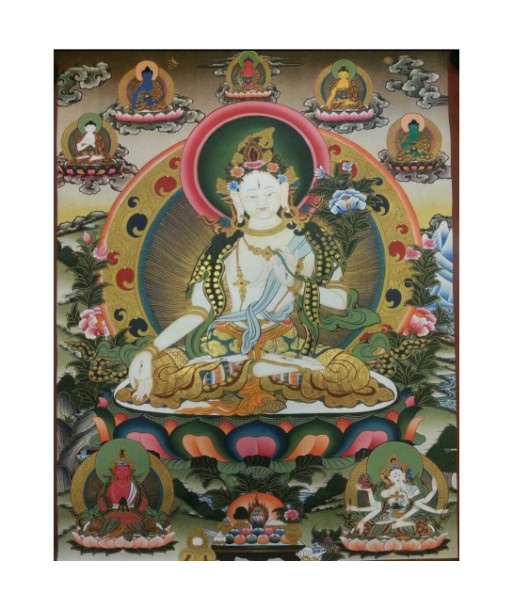- -50%






A **White Tara Thanka** painting features White Tara, a revered deity in Tibetan Buddhism known for her qualities of compassion, healing, and long life. White Tara is a manifestation of the Buddha’s compassion and is particularly associated with longevity and protection.
 Security policy
Security policy
(edit with the Customer Reassurance module)
 Delivery policy
Delivery policy
(edit with the Customer Reassurance module)
 Return policy
Return policy
(edit with the Customer Reassurance module)
A **White Tara Thanka** painting features White Tara, a revered deity in Tibetan Buddhism known for her qualities of compassion, healing, and long life. White Tara is a manifestation of the Buddha’s compassion and is particularly associated with longevity and protection.
### Key Elements of White Tara Thanka Painting:
1. **Central Figure**:
- **White Tara**: The central figure is White Tara, often depicted as a graceful and serene female deity. Her key features include:
- **Appearance**: White Tara has a pale, white complexion symbolizing purity and the healing aspect of her compassion. She is usually shown with a gentle and calm expression.
- **Posture**: She is often depicted in a seated posture, typically on a lotus throne or cushion, with one leg extended in a posture of readiness to assist beings.
2. **Attributes**:
- **Seven Eyes**: White Tara is sometimes depicted with seven eyes—one on her forehead, two on her palms, and two on her feet. These eyes symbolize her ability to see and help all beings and her vigilance over the world.
- **Lotus Flower**: She is often shown holding a lotus flower, which signifies her purity and spiritual wisdom.
- **Vajra or Jewel**: In some depictions, she may also hold a vajra (a ritual object representing indestructible wisdom) or a jewel, representing her role in bestowing blessings and protection.
3. **Iconography**:
- **Graceful Attire**: White Tara is adorned in beautiful, flowing garments and jewelry, reflecting her divine status and the beauty of her compassionate nature.
- **Radiant Aura**: A halo or radiant light often surrounds her, symbolizing her enlightened presence and the illumination of her compassionate energy.
4. **Background and Surroundings**:
- **Auspicious Symbols**: The background of the thanka might include auspicious symbols such as the Eight Auspicious Signs (Ashtamangala), which include the conch shell, lotus flower, and wheel of Dharma.
- **Sacred Landscape**: The painting may also feature serene and heavenly landscapes, such as lush gardens or mountain scenes, enhancing the sacred and peaceful atmosphere associated with White Tara.
5. **Mantras and Texts**:
- **Inscriptions**: Tibetan script or mantras related to White Tara’s blessings and healing may be included around or within the painting. These texts are often recited in prayers and rituals to invoke her protection and longevity.
### Significance:
- **Compassion and Healing**: White Tara embodies the qualities of compassion and healing. The thanka serves as a focal point for meditation and devotion, helping practitioners connect with her energy and seek her blessings for health and longevity.
- **Longevity and Protection**: White Tara is particularly associated with the wish for a long life and protection from harm. Her image in the thanka is used to invoke her power to safeguard and extend the life of those who practice her teachings.
- **Spiritual Practice**: The White Tara Thanka is used in rituals and meditation practices aimed at cultivating compassion, healing, and spiritual insight. Practitioners seek to develop qualities of kindness and wisdom, drawing inspiration from her serene and compassionate presence.
The White Tara Thanka is both a spiritual object and a devotional aid, reflecting the deep reverence for White Tara's qualities and her role in Tibetan Buddhism as a source of compassion, healing, and protection.